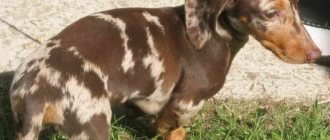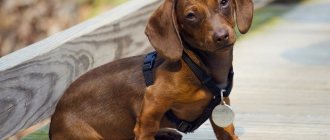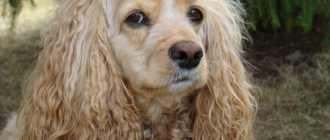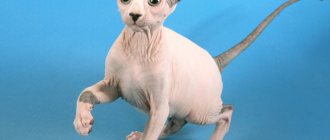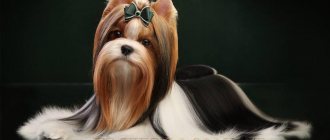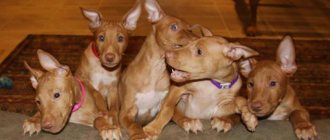It is fair to say that the Wirehaired Dachshund is the rarest variety of the breed. There are no substantiated reasons for such discrimination; most likely, it is a matter of aesthetics and preferences of “consumers”. Be that as it may, a wire-haired dog is in no way inferior to a smooth-haired or long-haired one, both intellectually and in working terms.
History of the origin of the breed
The Dachshund breed began to develop back in the sixteenth century in Southern Germany. The ancestors of modern taxis are short hounds.
Dachshunds quickly won the love of Europeans. And small game hunters always took a dog of this breed with them. Indeed, thanks to her body structure and hunting talents, she easily climbed into the small narrow holes in which the animal was located.
To improve the breed, breeders began to cross it with other small hunting dogs with hard, dense hair. The goal of the breeders was to increase the hunting aggression of the dachshund and thicken the coat, since hard wool better protects the four-legged dog from cold, humidity and injury. Over time, the body of the taxi drivers became longer and their height shorter.
The Wirehaired Dachshund was recognized in 1915, and at the same time a breed standard was established that is still valid today.
Health
The wire-haired rabbit breed does not have any health problems. But periodic examination of the eyes, ears, nails and teeth is necessary. The fur in the ears is removed as it grows back. Rub the eyes with a decoction of chamomile or strong tea. Nails are shortened with nail clippers designed for small breeds. It is also necessary to monitor the teeth; if tartar is found, it is removed in a veterinary clinic.
Important! Pets aged 7 years and older need strict control of stress, in the form of jumping, as this can have a detrimental effect on the spine.
In old age, the owner of a rabbit dachshund may encounter diseases such as:
- Joint dysplasia
- Cataract
- Diabetes
- Urolithiasis and other urinary tract diseases
- Heart failure
- Epilepsy
Important! The dog is prone to obesity. When overeating, your pet develops joint problems and metabolic disorders occur.
What does it look like
Dimensions and weight of an adult dog
The wire-haired dachshund has three subspecies, which differ from each other in size.
So, a standard dog weighs 7-9 kilograms and has a height at the withers of up to 35 centimeters. Males are larger than females. The rabbit variety is smaller: its weight is 3-5 kilograms and its height is 30-33 centimeters. And the smallest type is a dwarf dog, not exceeding 30 centimeters in height and weighing 2-3 kilograms.
Head, nose, eyes and ears
The head of the gesture is shaped like a wedge with a pointed end. The jaws are developed and powerful, the back of the head also stands out. There is also a hard “beard”, characteristic of the wire-haired breed.
The dachshund's nose has a straight, even back and developed nostrils. Its color is either black or brown, depending on the color of the dog's coat.
Oval eyes are usually bright brown, less often amber or blue.
Dachshund ears are droopy and hang neatly on both sides. Their shape is triangular, they are quite large and rounded at the tip.
Neck and body
The wirehaired breed has a strong neck and a developed scruff. Males have more muscular withers than females.
The dachshund's body itself is large, with an oval protruding chest. The lower back is elongated, the tummy is tucked.
Limbs and tail
The short legs of the gesture are located parallel to each other. The joints of the limbs are developed, the elbows are pressed to the chest. The hind legs are longer than the front legs and are wider apart.
The tail of the gesture is straight, hanging down slightly. A crescent shape is also acceptable. According to the standard, the ponytail should not fall on the back or stand up.
Coat color
The color types of wirehaired taxis are as follows:
- Plain.
- With stains.
- Brindle.
- Two-color.
- Marble.
The colors found in rough-haired dachshunds are black, tan and brown. And small and recently born puppies have a boar color (from a light reddish tint to a dark brown color).
Wire-haired taxis have three main color categories:
- Plain. As a rule, it is red, red or brown. The color on the chest is usually lighter than on the main body.
- Two-color. This is a combination of dark colors - black or brown with red. This is the most common coat color in the breed.
- Blue merle. This is a rare color type that includes brindle and merle. Puppies with such fur are rare, so they are much more expensive than others.
Types of Wirehaired Dachshunds
Dwarf Wirehaired Dachshund
A miniature or dwarf wire-haired dachshund weighs no more than five kilograms, and its height is 30-35 centimeters.
Rabbit wirehaired dachshund
The rabbit subspecies of taxis are the tiniest representatives of the breed. Their height does not exceed thirty centimeters, and their weight is only 2-3 kilograms.
Standard Wirehaired Dachshund
The standard rough-haired dachshund is the most common of the breed. Her height is from 35 centimeters, and her body weight is from 7 to 9 kilograms.
Character and behavior
Gestures are friendly and sociable pets. They get along easily among people and their children. But such pets also have proper self-respect: if he is offended, unreasonably scolded and reprimanded, he will behave accordingly. The pet is able to stand up for itself.
Therefore, if you keep a wire-haired dachshund with a child, you must explain to him that the dog is also a member of the family and you cannot harm it, offend it or beat it. But you shouldn’t leave these two alone; after all, taxis are a hunting breed.
Features of the behavior and character of rough-haired dachshunds include:
- the ability to protect and protect your family;
- these kids will create an atmosphere of fun in the house;
- Taksyata are faithful and devoted comrades. Left alone, they are very worried and miss their owner;
- These are very hardy and physically strong dogs. They are able to run around the apartment all day without a break without getting tired. There is no need to scold your pet for such energy, because this is inherent in its nature. To prevent your baby from throwing out energy at home, you need to take him for walks and play in the fresh air more often;
- Dachshunds are a smart breed with considerable mental abilities;
- Some rough-haired dachshunds are not too fond of other pets in the house. They often perceive small domestic animals as prey;
- Dachshunds are indifferent to strangers. Sometimes, but rarely, they bark at strangers, but the dog will never rush into battle without a reason.
Photos of main colors
The standard colors of wire-haired dachshunds can vary over a fairly wide range.
It can be:
- red with a small amount of black hair, this color is popularly called fawn. Moreover, shades of red can vary from sandy-spit to rich red;
- The two-tone color is usually black or light brown with red or tan markings. As a rule, tan marks are located on the sides of the muzzle, lower jaw, inside of the ears, paws, lower part of the tail, under the tail and chest;
- brown and tan color can be distinguished separately as the most common color among wire-haired dachshunds;
- The “boar” color is recognized by standards only for wire-haired dachshunds and is also very common. The palette of shades varies in red-brown tones;
- The brindle color is also quite popular for wire-haired dachshunds. Dogs with this color often take prizes at shows;
- white-brown color - it is distinguished by the fact that the main color of the coat of such dogs is white, and large spots of darker colors (red, brown, black, chocolate) are scattered throughout it. With this color, the dog also has tan marks.
Care and maintenance of the gesture
Feeding
An adult dachshund is fed twice a day. If you give your pet dry food, then you need to buy a product of at least premium class. Even better - super-premium or holistic (environmentally friendly food). The fact is that food from the “economy” segment causes more harm to animals than good.
If you feed your pet natural food, you need to make sure that he receives the required ratio of all nutrients, vitamins and minerals. Authorized products include:
- Lean meat (accounts for more than half of the total diet).
- Kefir, cottage cheese and other fermented milk.
- Vegetables fruits.
- Porridge, cereals.
There is no need to give your wire-haired taxi dog sweets, spicy and smoked foods, as well as flour products. Any food from the usual table is harmful to the dog.
Education and training
Wirehaired dachshunds are extremely active dogs, so their energy needs to be channeled in the right direction. If the gesture immediately senses the authority of the owner, he will be more flexible. Otherwise, the pet will behave wayward and stubborn. Training an adult dachshund is much more difficult.
It is necessary to raise and train a wire-haired dachshund from puppyhood - from two months. Dog trainers recommend teaching your puppy commands such as “Fu” and “No” before the first walk outside. After all, dachshunds are curious animals that do not need a reason to take and eat something from the ground or climb into any hole.
A few important training rules:
- Violent methods must not be used. And also force, scold, and even more so beat your pet. This way you can discourage the baby dachshund from all interest in activities, and he will be afraid of his owner.
- Each correct gesture should be rewarded with a tidbit and verbal praise.
- If the pet is not in the mood to exercise, then you need to postpone training for another day.
Vaccinations and diseases
Taxi drivers are in excellent health. Their life expectancy reaches 12-15 years. Usually, with the right lifestyle, various diseases appear only in old dogs. Diseases characteristic of the breed include:
- Swimmer's syndrome. It develops in puppies that are unable to stand on their feet, or in pets with severe obesity or injuries.
- Heart failure and other heart problems.
- Diseases of the genitourinary system, including urolithiasis.
- Eye pathologies, including cataracts and retinal atrophy.
- Dysplasia of intervertebral discs and joints.
Wirehaired rabbit dachshunds are somewhat weaker in health than the standard species. They often suffer from viral diseases and epilepsy.
To protect your pet from serious infectious diseases (distemper, leptospirosis, enteritis, etc.), it is necessary to vaccinate it in a timely manner. The first vaccination for a tiny dachshund is given at two months of age. Three booster vaccinations will be required up to 12 months of age. As soon as the baby turns one year old, the vaccine is given annually, at the same time.
At one year the dog is vaccinated against rabies.
Mating, pregnancy and childbirth of a dachshund
The wirehaired dachshund is physiologically ready to give birth when it is one year old. There is no need to breed your pet during the first heat cycle; during this period, she is not yet sufficiently formed to bear offspring and give birth. It is optimal to breed a female after her second heat. Males are ready for mating at six to eight months. Mating occurs on the male's territory from one to three times.
Dachshund pregnancy lasts 63 days, that is, a little more than two months. The health of the future offspring directly depends on the care of the pregnant female.
At one time, the wire-haired dachshund gives birth to one to five puppies. Their weight depends on the size of the mother, for example, standard-sized dachshunds usually give birth to fairly large puppies.
Trimming
Coarse-haired dogs require trimming. This procedure involves plucking dead fur using a special device. Trimming is usually carried out in salons, but any owner can learn this at home.
Trimming is carried out at least once every 6 months.
A haircut
Rough-haired dachshunds are allowed to be cut only in the head area, that is, to give shape to the goatee, eyebrows and mustache. Pets with coarse hair are not cut due to the fact that it spoils the structure of the dense coat. It will become soft and weak after cutting.
Coarse-haired taxis have a peculiarity - they go bald at the withers. This is normal and does not require action.
Care for eyes, ears, claws
Lack of care for eyes and ears leads to various diseases. After all, accumulated mucus, wax or plaque is an ideal environment for bacteria to multiply. And long claws interfere with the dog’s movement and disrupt the musculoskeletal structure of the body.
Therefore, the following procedures must be carried out regularly:
- wipe the eyes of the wire-haired taxi dog with a swab dipped in warm boiled water. If there is redness or inflammation of the eyes, you need to wipe them with strong brewed tea;
- To clean your ears, use cotton pads, hydrogen peroxide or a special lotion. Remove wax accumulated in the ears and trim the hair growing in them;
- Nail trimming is another important procedure for your pet. To do this you need to purchase a nail clipper. Only the transparent part of the claw, empty from the inside, needs to be cut off. As a rule, it is 2-3 mm (sometimes less, especially in puppies). If you accidentally hurt your pet, there is no need to panic, you need to treat the wound with hydrogen peroxide and continue cutting further.
Grooming
A rough-haired dachshund cannot be cut. The exception is participation in exhibitions. Instead of a haircut, gestures need trimming. It is carried out in special salons, but you can learn to do it yourself.
Every day the dog should be combed out using a comb with sparse teeth. During molting, brushing of the wire-haired quadruped is carried out even more often: several times a day.
To make it easier to comb dachshunds with coarse hair, silicone products are sold that are applied to the coat before the actual procedure.
Accepted standard
Official appearance standards :
- the head has an elongated shape;
- the nose is narrowed towards the tip. The ideal nose color is black, but brown is also acceptable;
- eyes are dark, clear, oval in shape;
- ears hanging, rounded, set high;
- paws are wide, short, strong, widely set;
- the tail is straight or sickle-shaped, located just below the line of the back;
- The coat is thick, hard, and evenly distributed throughout the body. There is a mustache, beard and thick eyebrows;
- “Boar color” predominates in coloring, but black stripes and minor spots are acceptable.
Expert opinion
Kozhevin Semyon Kirillovich
Expert dog handler.
Almost all wire-haired rabbit dachshunds can be called smart and intelligent dogs. The main thing that is required of you is the correct uprising. You need to find an approach to your pet. A rough attitude can lead to a dog growing up stubborn, nasty and disobedient.
Advantages and disadvantages of the breed
The advantages of the coarse-haired breed are:
- Sociability and friendliness.
- Quick wit and high intelligence.
- Thanks to its hard coat, it does not require particularly careful grooming.
- Cheerful disposition, no tendency to depression or despondency.
- They love children and play calmly with them.
- Adaptability to harsh weather conditions.
The disadvantages of wirehaired taxis include:
- Stubbornness and desire to play pranks. Sometimes it's not easy to calm a dog down.
- The need for frequent and active walks.
- Does not like other small animals in the house.
- He cannot stand loneliness and misses his owner greatly.
Of course, disadvantages are a subjective thing. For some, active and restless dogs are a headache, for others they are a real treat. Therefore, you need to focus on your personal feelings.
Torso
The wire-haired dachshund has a very elongated body. It's quite massive. The withers are muscular. This feature is more pronounced in males. In the stance, the falling line of the back from the withers to the croup is clearly visible. It is less common to find individuals in which it runs straight. The belly of dachshunds does not hang, the line is smooth, slightly arched. The chest is well defined. It has an oval shape, not very wide, but elongated. The lumbar region is elongated. It smoothly transitions into a muscular croup.
Who is the Wirehaired Dachshund suitable for?
Since Geese are very energetic dogs, they need an equally active owner. He must be prepared for long walks and intense play with the pet. The future owner must be quite patient, because there will be a lot of noise and mischief in his house.
Therefore, people who lead a measured and calm lifestyle and are not ready for its radical change should not start using gestures.
Description of the variety
The wire-haired rabbit dachshund can be described as an animal with a harmonious build, strong muscles and strong bones.
Its appearance is the same as that of other varieties of dachshunds.
She has:
- dense, compact, muscular body;
- strong short limbs;
- the front paws are larger than the hind paws;
- eyes dark, medium size;
- the muzzle is oblong;
- the nose is narrowed towards the tip;
- The ears are set high, but hang down and have a rounded shape.
NOTE!
With the right approach, the dog is easy to train and quickly learns commands. And for good physical development, she needs daily walks and active games. With proper training, by the age of 6 months the dog will develop hunting skills.
How to choose a rough-haired dachshund puppy?
Rules to help you choose a wire-haired puppy:
- contact only official nurseries with an established reputation;
- you need to study the baby’s pedigree: what his parents and brothers and sisters look like, whether they are sick with anything;
- it is necessary to study the baby’s shelter diet;
- if the puppy does not go into your arms, does not show activity and sits in the corner - perhaps he is sick;
- you need to make sure that the puppy does not have parasites (both skin and intestinal), and that there are no discharges on his eyes and nose;
- you need to try to pick up the baby. If he freezes and tenses, he is scared. It will be more difficult to establish contact with him. If the baby does not sit in his arms and is actively struggling, perhaps he has not yet learned to calm down on his own.
But still, the main selection criterion is the call of the heart of the future owner. Any puppy deserves love and life among people.
Dossier
Height of an adult dog: 15-35 cm. Weight: 5-12 kg. Characteristic color: different shades of red, black and red. Coat length: medium. Life expectancy: up to 14 years. Advantages of the breed: high intelligence, good hunting instinct, devotion. Difficulties of the breed: jealous, loves to dig, can spoil things if not given enough attention. Average price: 200-1000 dollars. Classification: small, medium, hunting, companion.
Questions and answers
Who is the Wirehaired Dachshund suitable for?
Active, energetic and quite patient people. For those who prefer a quiet way of life (for example, older people), coarse-haired taxis are not suitable.
What is the character of a wire-haired dachshund?
Wirehaired Dachshunds are highly energetic dogs known for their intelligence, loyalty, and love of people. The hunting instincts of tacks often make themselves felt: on walks they climb into different holes and run away, at home they chase other domestic animals. But a more devoted person cannot be found as a guard and protector.
Character
The Dachshund is a companion dog that can easily get along with people of different ages. She loves children, especially small ones, and can play with them for hours. However, representatives of the breed respond with such good nature only to an appropriate attitude towards them. If a child constantly pulls the pet’s tail or causes other harm, the dog will stand up for itself.
Hunting instincts also shape the animal's character. They are distinguished by activity, energy, and curiosity. If you plan to take your pet hunting, you need to understand how important it is for him to have the opportunity to throw out his accumulated energy. Long, active walks are one of the main factors ensuring the normal condition of the animal.
The cheerfulness and positivity emanating from wire-haired dachshunds creates a special atmosphere in the house. They are loyal to the owner, his family, and can take care of children, performing not only a frolic function, but also a security function.
Despite the positive nature of wire-haired dachshunds, keeping them in a home with other small animals, especially rodents, is dangerous. Hunting instincts will constantly disturb the dog, causing aggression and other negative qualities.
Training
Wirehaired dachshunds are very smart dogs. They are easy to train, but at first you will still have to be patient. After all, you need to prove to your pet that you are the owner. Make it clear from childhood what can and cannot be done.
Feeling your care and authority, the dog will follow any commands to please you . After each successfully completed task, praise your pet and treat it with a treat. If you use a dog for hunting, then you will need professional training on machines.
Purpose
Even before human intervention, dachshunds were excellent hunters. This can be seen from their unusual body structure, which allows them to extract prey from burrows, from their strong paws and muscular body. People used them to hunt badgers. Nowadays, animals most often become a pet companion. More suitable for a family that leads an active lifestyle.
